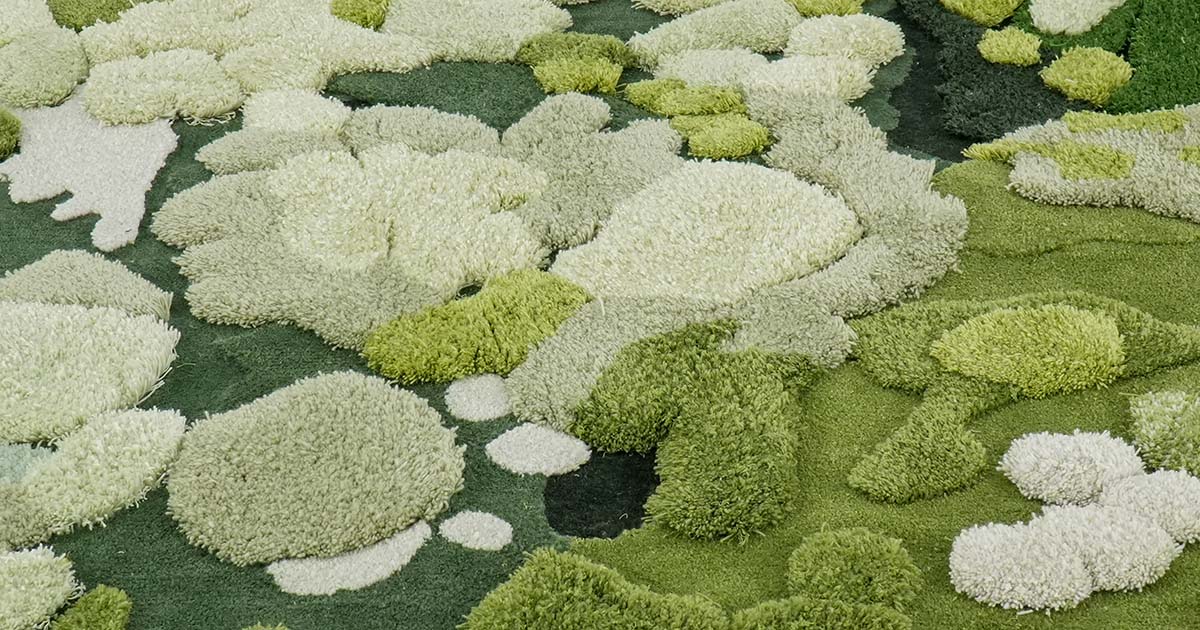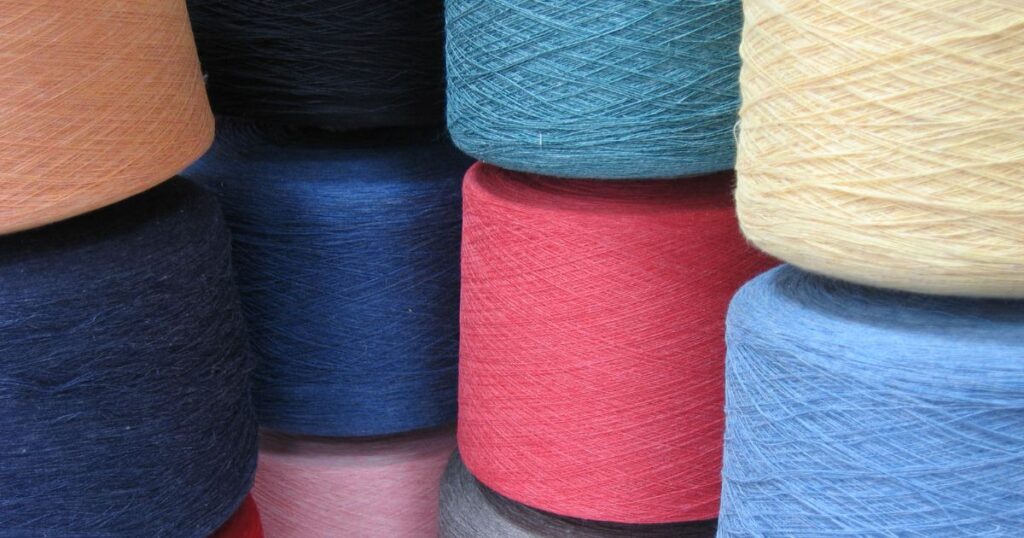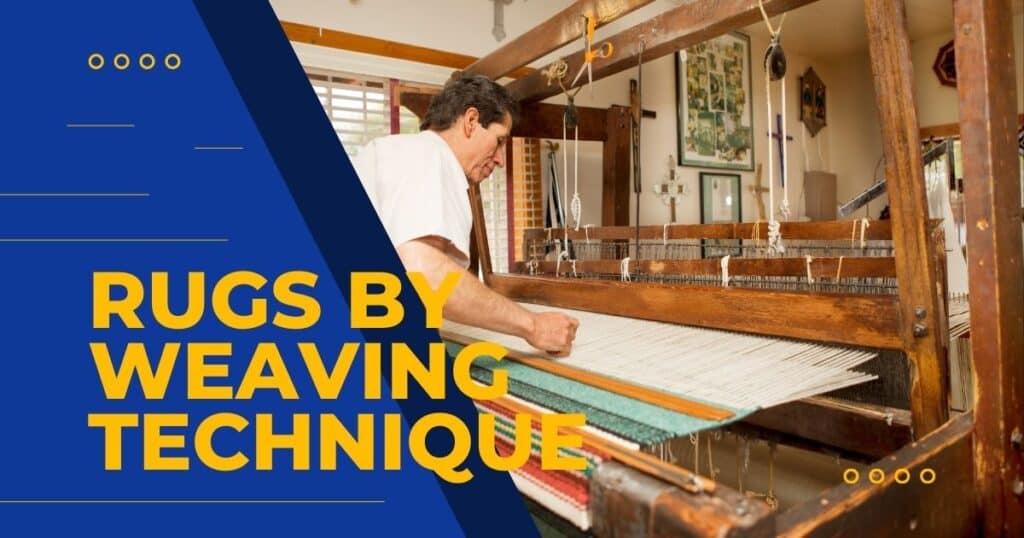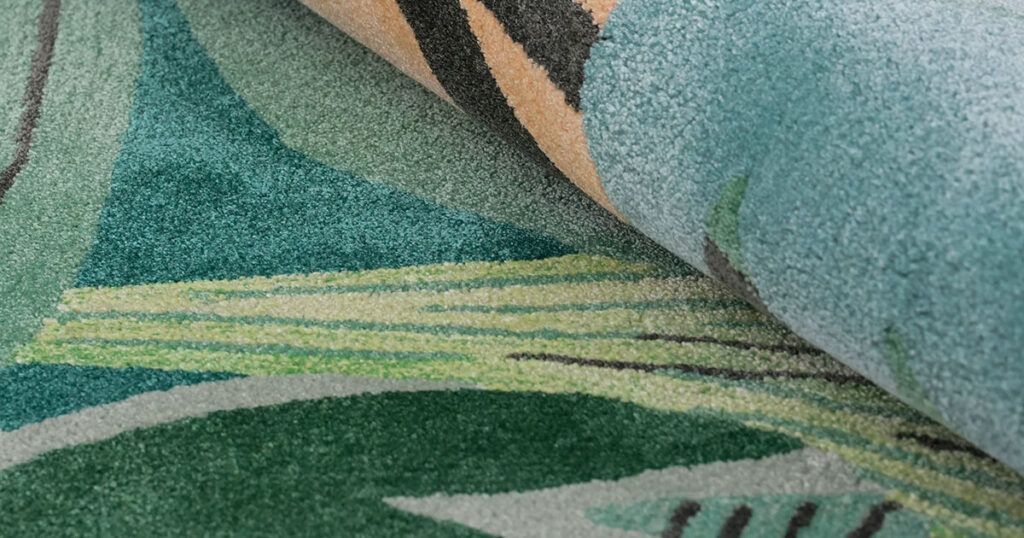When shopping tufted rugs or ordering custom tufted rugs, you may see the terms “hand tufted” and “machine tufted”.
This guide will help you understand their differences.
After reading this post, you will know essential things like durability, cost, design flexibility, production time, and maintenance.
Tufted Rug Construction
Foundation of Tufted Rugs
As a tufted rug maker, we produce tufted rugs by inserting yarn through a base fabric to form the rug’s pile.
Then, use water-soluble latex glue and a secondary backing to secure the fibers.
- This method is faster and more cost-effective than hand-knotting.
- That is why tufted rugs a popular choice for custom commercial interiors.
What is a Hand Tufted Rug?
A hand tufted rug is created by a worker using a handheld tufting gun.
- The process begins with stretching a backing cloth cloth on a frame.
- The desired pattern is typically stenciled onto this cloth as a guide for the craftsperson.
The worker then uses the tufting gun to punch yarn through the cloth.
During the whole process, the workers do tufting for every detail of the rug until it is completed.
- These loops can be left intact for a loop pile or cut to create a cut-pile texture.
After completing the design, the rug is removed from the frame
Then we coat the back with latex glue to secure the tufts.
- Next, a secondary backing (usually scrim or canvas) is applied over the glue for additional strength and a finished appearance.
Hand tufted rugs typically feature:
- A thick, plush pile that feels luxurious underfoot
- The potential for varying pile heights within the same rug
- Carved details that add texture and dimension
- A distinctive handcrafted quality where subtle variations add character
- Flexible design capabilities, including irregular shapes and organic patterns
The artisanal nature of hand tufting means each rug is essentially custom-made.
The craftsperson’s skill determines the precision and quality of the final rugs and carpets.
What is a Machine Tufted Rug?
We can also produce tufted rugs with computer controlled tufting machines.
The general concept for such tufting machine is to hold the tufting gun using pre-designed mechanical devices.
And then the tufting machine moves the tufting gun according to preset patterns in its program.
- Tufting machines allows for precise, consistent tufting across large areas
- The machine can create carpet very quickly in large continuous lengths
- Commonly as broadloom rolls that are later cut into rugs or installed wall-to-wall
The construction at the yarn level is similar to hand tufting but executed at industrial speed.
Meanwhile, after the tufting procedure, the following production steps are the same as those for hand tufted rugs.
Machine tufted rugs typically feature:
- Consistent tuft density and pile height
- Highly uniform appearance and texture
- Production in standard shapes and sizes
- Often use of synthetic yarns like nylon or polypropylene for durability
- Large-scale production capabilities ideal for expansive areas
Traditional machine tufted carpets were often made in solid colors or simple textures, and later had patterns printed or dyed onto the surface.
Modern tufting machines allow multiple colors of yarn to be tufted in sophisticated patterns using computer-guided yarn placement.
Detailed Comparison
Durability and Longevity
Hand Tufted Rugs:
Hand tufted rugs are known for their robust construction with a layer of thick, dense pile.
A well-made hand tufted rug can handle high foot traffic areas in commercial settings like hotels and offices.
Their sturdy build and dense pile can withstand public foot traffic while still looking plush.
The durability specifics include:
- A typical lifespan of 10-20 years with proper care and maintenance
- Natural wool fibers that resist crushing and maintain appearance
- Strong resistance to general wear in moderate to high traffic areas
- The ability to withstand public foot traffic while maintaining a plush appearance
However, there are some durability considerations:
- The latex adhesive begins to age from application and can eventually dry out
- In very warm or humid environments, latex deterioration can accelerate
- Over many years, the backing may loosen slightly or develop ripples as the glue fails
- The rug may shed initially (especially wool), requiring more frequent vacuuming at first
For moderate to high traffic areas that aren’t subjected to extreme wear conditions, a hand tufted rug with good wool quality and dense pile can last quite long.
Surely, much longer than tufted “throw rugs” meant for light residential use.
Machine Tufted Rugs:
Machine tufted carpets, especially those engineered for commercial and hospitality use, are designed for high durability.
They often use heavy-duty synthetic fibers like solution-dyed nylon that are extremely tough and wear-resistant.
- The tufting process allows very high stitch counts (tuft density) and strong backing bonds.
- It means these rugs and carpets can hold up under constant foot traffic, rolling carts, and other stresses common in commercial environments.
Key durability factors include:
- Very high stitch counts (tuft density) that resist crushing and wear
- Strong backing bonds that maintain structural integrity under stress
- ngineered fibers that withstand constant foot traffic, rolling carts, and commercial wear
- Testing for factors like abrasion resistance, tuft bind, and appearance retention
- Commercial grades designed specifically for hospitality, healthcare, or office environments
The manufacturing process allows precise control over factors that influence durability, making these rugs ideal for extremely high-traffic areas.
Commercial-grade machine tufted rugs often use improved backing materials and adhesives to minimize early breakdown.
In general, machine tufted rugs get the edge in durability for very high-traffic or demanding conditions
This is because of engineered fibers and tightly controlled production that maximizes wear performance.
Cost and Budget Considerations
Hand Tufted Rugs
Hand tufted rugs require a lot of human labor working hours.
The skilled artisans have to manually tuft the design.
- This craftsmanship, combined with premium materials, contributes to a higher cost per square foot compared to machine-made options.
- For some small sizes or complicated patterns, the labor cost is even higher than the yarn.
Cost factors include:
- Labor costs for skilled artisans to hand tuft the design
- Premium materials like New Zealand wool or silk accents
- Design complexity (more colors or intricate patterns increase cost)
- Pile density (higher density means more yarn and labor)
- Finishing details like carving or varied pile heights
Hand tufted rugs represent a mid-range investment—not the cheapest flooring option, but offering a bespoke look at a lower cost than true hand-knotted rugs.
- An important advantage is that we tufted rug makers have no minimum order requirement.
- You can commission a single tufted rug with complete customizations – its size, shape, yarn types, pile types, etc.
This makes hand tufting cost-effective for one-off statement pieces.
Machine Tufted Rugs
Machine tufted carpeting is generally the most cost-effective way to produce rugs or carpets, especially in large quantities.
- Once a design is programmed and the machines are set, production output is very high, driving down the per-unit cost.
- If you choose synthetic yarns – like acrylic, nylon – for your tufted carpets, you can further reduce cost.
Cost advantages include:
- Highly efficient production process that reduces labor costs
- Typically uses synthetic materials that cost less than premium wool
- Economies of scale make large orders significantly more affordable
- Standardized manufacturing process reduces variables and expense
- Lower overall cost per square yard compared to hand tufted options
For standard designs and large orders – like carpeting multiple hotel rooms or retail locations, machine tufted is typically significantly cheaper per square yard than hand tufted.
The economy of scale is substantial.
- You may not see a price difference if you order only one small machine tufted rug.
- This is because the material cost and setup cost do not have big differences.
But producing hundreds of square feet becomes quite budget-friendly per unit.
Some manufacturers require minimum yardage requirements for custom machine tufted runs.
This is not good if you look for various sizes and designs, or begin the cooperation with test orders.
- For example, a minimum size of 300 x 200 cm and a minimum order quantity of 3 pieces for the same design.
However, at Mirugcle company, we does not require a minimum size and quantity, because we can do both hand tufting and machine tufting flexibly.
Design Flexibility and Aesthetics
Hand Tufted Rugs
This the most important reason when you must choose hand tufted rugs.
The hand-tufting process offers nearly limitless design possibilities.
Allow for artistic expression and custom creations.
Design capabilities include:
- The ability to follow virtually any pattern or artwork drawn on the canvas
- Complex motifs, flowing curves, and intricate logos rendered with precision
- A wide array of colors from pre-dyed yarns matched to design specifications
- Irregular shapes created by tufting and then cutting along specified outlines
- Varying textures by combining cut pile and loop pile in the same rug
- Sculpting effects through carving patterns into the pile
- Different pile heights to create dimension and textural contrast
- Organic, artisanal appearance with subtle variations that add character
This flexibility makes hand tufted rugs ideal for various rug designs you can imagine:
- Bespoke designs, company logos, or artistic pieces that need to perfectly match a design.
They can truly function as artwork for the floor, with each piece being unique.
For commercial clients aiming to make a design statement (like a striking lobby rug that reinforces branding), hand tufting provides the flexibility to realize that vision without machine constraints.
Machine Tufted Rugs
Machine tufted carpets have historically had limitations in design flexibility.
But technology has dramatically improved their capabilities.
Latest tufting machines offer increasingly sophisticated design options.
Design considerations include:
- Traditionally based on repeating patterns determined by needle configuration
- Multi-color designs achieved either through multiple yarn sets or post-tufting printing
- Modern Computerized Yarn Placement (CYP) technology allowing for detailed patterns
- Digital printing capabilities that can create photorealistic effects on tufted bases
- Precision and consistency in pattern execution across large areas
- Usually produced in standard rectangular shapes (odd shapes require post-production cutting)
- Some limitations on color selection and pattern complexity depending on machine capabilities
- Rapid implementation of new designs once programming is complete
Machine tufted rugs can follow design trends quickly because production is fast once a design is set up.
For businesses wanting modern patterns across multiple locations, machine production offers consistency and efficiency.
However, for highly custom designs (like a hand-painted artwork effect or very irregular layout), machine tufted options may not capture the organic quality that hand tufting provides.
Production Time and Lead Times
Hand Tufted Rugs:
Creating a hand tufted rug takes significantly less time than knotting a rug by hand.
But it remains a manual process requiring skilled craftsmanship.
Typical production timelines:
- Medium to large hand tufted rugs may take 8-10 weeks to complete
- The process includes plotting the design, tufting the entire rug by hand, and finishing
- More complex designs with multiple colors or intricate details take longer
- Larger sizes naturally require more time to complete
- Multiple rugs can be worked on concurrently by different artisans if needed
For commercial interiors requiring fast delivery, businesses often choose hand tufted rugs because they can be turned around quicker than fully hand-woven rugs without requiring large minimum orders.
For a limited quantity of custom pieces, hand tufting offers reasonable and predictable lead times, generally on the order of a couple of months for production.
Machine Tufted Rugs:
Speed is one of the major advantages of machine tufting, especially for large volume orders.
In an industrial tufting facility, carpet can be produced at an impressive rate.
Production speed factors:
- Hundreds of square yards of carpet can be tufted in a single day
- Large commercial projects can be completed very quickly once design and specs are finalized
- Lead time includes design development, yarn dyeing, and production scheduling
- Manufacturers may have minimum order requirements that affect scheduling
- Custom designs may take longer to set up but still produce quickly once running
- Digital printing on tufted carpet can produce unique rugs rapidly
For large commercial projects requiring identical carpet throughout (like hotel corridors or chain retail locations), machine tufting delivers unmatched speed.
If time is of the essence for a large installation, machine tufted is typically the way to go.
For smaller custom orders, the speed advantage may be less pronounced, as scheduling and minimum requirements might offset the faster production time.
Guidance for Commercial Settings
Offices
For corporate or institutional offices with different functional areas, both tufting methods have appropriate applications depending on the specific space and its requirements.
Reception and Lobby Areas
Reception areas serve as the face of a company, making them ideal locations for hand tufted statement pieces.
These areas often justify the investment in custom designs that incorporate company branding because they create immediate impressions on visitors.
A hand tufted rug featuring the company logo or brand colors makes a powerful visual impact while demonstrating attention to detail.
The design flexibility of hand tufting allows for perfect coordination with architectural elements and furniture, creating a cohesive first impression.
Open Office Work Areas
In large open office spaces, practical considerations typically favor machine tufted solutions.
Machine tufted carpet provides cost-effective coverage across expansive areas while offering the durability needed for constant foot traffic.
Many offices now use modular carpet tiles (which are machine tufted) to allow for easy replacement of worn or damaged sections without disrupting the entire floor.
Low-pile commercial grades stand up well to the constant movement of office chair wheels and heavy furniture rearrangement.
Main corridors particularly benefit from the wear resistance of machine tufted carpets designed specifically for commercial use.
Conference Rooms and Executive Offices
Conference rooms present unique challenges, requiring flooring that balances professional appearance with practical durability.
Machine tufted low-pile options work best under conference tables where chairs frequently roll back and forth.
These spaces benefit from acoustical considerations as well—denser pile helps absorb sound in meeting spaces, improving speech clarity during presentations.
The designs can maintain corporate identity while offering sufficient durability for frequent furniture rearrangement.
For executive offices, hand tufted rugs often make sense as design statements that convey status.
Higher-end materials like wool with silk accents provide visual luxury while custom sizing ensures the rug fits perfectly within the room’s proportions.
Since executive offices typically see moderate rather than heavy foot traffic, more delicate designs and textures can be practical choices.
Break Rooms and Casual Areas
Informal gathering spaces benefit from thoughtful rug selection that balances comfort with practicality.
Hand tufted rugs with playful designs help define casual seating zones and create inviting environments for relaxation or collaboration.
For areas near food preparation or coffee stations, machine tufted options with stain-resistant properties offer more practical solutions.
Retail Environments
Retail spaces vary dramatically in their flooring needs, from luxury boutiques to high-volume chain stores.
The right rug choice depends on the store’s brand positioning, customer experience goals, and practical requirements.
High-End Boutiques
In luxury retail settings, hand tufted rugs contribute significantly to creating an exclusive shopping experience.
These custom designs complement merchandise displays and reinforce brand aesthetics.
The tactile experience of walking on a plush wool rug enhances customer comfort and extends browsing time.
Some retailers even change their rugs seasonally to refresh the store environment and reflect new collections, making hand tufted rugs part of their merchandising strategy rather than just floor covering.
Chain Retail Locations
National retailers with multiple locations typically prioritize consistency, cost-effectiveness, and durability.
Machine tufted carpets ensure uniform branding across all stores while offering economical solutions for large floor areas or multi-site rollouts. Standardized designs maintain brand identity throughout the chain while controlling costs.
The durable synthetic fibers commonly used in machine tufted commercial carpeting withstand shopping cart traffic, constant customer flow, and regular cleaning protocols required in busy retail environments.
In the rest of the retail space, the choice between hand and machine tufted varies by area function.
Fitting rooms and display areas often benefit from hand tufted accent rugs that define special zones within the larger space.
These areas use textural variation and pile height differences to create visual interest, with designs that highlight featured merchandise.
In contrast, entrance areas typically require highly practical machine tufted mats with moisture resistance to manage wet weather tracking.
Darker colors and patterns help hide soil at these high-traffic entry points, and replacement might be needed seasonally in harsh climate locations.
Hospitality Settings
Hotels and restaurants have particularly diverse flooring needs across their many functional areas.
Both hand and machine tufted options play important roles in creating comfortable, durable, and aesthetically pleasing environments.
Hotel Public Areas
Hotel lobbies make ideal showcases for large custom hand tufted rugs that create magnificent focal points.
These dramatic designs set the tone for the guest experience from the moment they enter the property.
The artisan quality of hand tufted rugs communicates luxury and attention to detail, important messages in hospitality settings.
Strategic placement under seating areas helps define conversation zones while managing acoustic properties in these often vast spaces.
The corridors leading to guest rooms present different requirements. Here, machine tufted broadloom provides consistent coverage across long hallways while offering the durability needed for luggage wheels and housekeeping carts.
Pattern selection becomes critical—designs that disguise soil and stains between cleanings reduce maintenance costs.
The sound absorption qualities of carpet also improve guest comfort by reducing noise transfer between rooms, an important consideration in hospitality design.
Guest Rooms and Dining Areas
Within guest rooms, a hybrid approach often works best.
Smaller hand tufted accent rugs add a residential feel to seating areas while machine tufted wall-to-wall provides practical full coverage elsewhere.
This combination balances luxury with practicality while allowing for the quick turnover needed between guests.
Maintenance cycles become an important consideration since rooms must be quickly prepared for new arrivals.
Restaurants and bars benefit from different flooring solutions depending on the zone.
Hand tufted rugs in waiting areas or private dining rooms add sophistication without exposure to food spills.
The dining areas themselves typically require machine tufted options with stain-resistant properties. Pattern complexity proves valuable here by hiding inevitable food and beverage spots.
Both rug types contribute to sound absorption, improving the dining experience by reducing ambient noise that interferes with conversation.
Large ballrooms and event spaces almost always utilize machine tufted carpets that cover expansive areas consistently.
These designs often incorporate venue branding or thematic elements while modular systems allow for replacement of damaged sections without replacing the entire floor.
Durability requirements are significant, as these spaces must withstand temporary walls, staging, and heavy event equipment.
Public and Commercial Lobbies
Government buildings, museums, and corporate headquarters face unique flooring challenges that require balancing impressive aesthetics with practical durability concerns.
The immediate entrance zones typically prioritize function over form, with durable machine tufted entrance systems managing outside soil and moisture.
Practical considerations necessarily outweigh aesthetics in these high-wear areas where regular replacement may be necessary, particularly in locations experiencing extreme weather.
Maintenance systems must address heavy soil loads from street traffic while maintaining safety and appearance standards.
Beyond the entry, central lobby areas offer opportunities for signature hand tufted rugs that define seating or gathering spaces.
These custom designs often reflect the organization’s mission or history through thoughtful motifs and color schemes.
Strategic placement beyond the immediate entrance provides protection from outside elements while creating visually impressive focal points that justify higher investment and maintenance requirements.
For broader institutional settings like government offices or public buildings, machine tufted broadloom or tiles provide practical, durable solutions that work within typical budget constraints.
These spaces often incorporate subtle institutional colors or branding elements in their flooring design.
The low maintenance requirements accommodate limited facility resources, and budget considerations frequently favor machine tufted options for these extensive interior spaces.
Making the Right Decision
Selecting between hand tufted and machine tufted rugs for your commercial project involves weighing multiple factors.
Understanding these considerations will help you make an informed choice that balances aesthetics, functionality, and value.
Key Decision Factors
Project scale plays a significant role in your decision-making process.
Consider whether you need a single signature rug or multiple identical pieces throughout your space.
Calculate the total square footage required and whether you have multiple locations needing a consistent appearance.
Large-scale needs typically favor machine tufted options for consistency and economy, while one-of-a-kind statement pieces benefit from hand tufting.
Traffic Patterns
Traffic patterns should heavily influence your selection.
Analyze how many people will walk on the rug daily and whether it will face additional stresses like rolling carts, luggage, or wheeled furniture.
Consider if the placement is in a main thoroughfare or a less-traveled area.
High-traffic zones generally benefit from the engineered durability of machine tufted options, while moderate-traffic showcase areas can feature hand tufted designs.
Design Requirements
Design requirements may determine which option is most appropriate.
Evaluate whether your design includes a detailed logo or intricate artwork that would benefit from hand tufting’s flexibility.
Consider if irregular shapes or organic patterns are important to your concept.
The number of colors needed and any textural variations or sculpted effects desired may make hand tufting the more suitable choice despite higher costs.
Budget constraints naturally influence decisions for any commercial project.
Determine your total flooring budget and whether there’s room for investment in focal areas while economizing elsewhere.
Consider the expected replacement cycle and how it affects lifetime costs.
Machine tufted options generally offer better long-term value for high-wear areas, while hand tufted pieces might be worth the investment for signature spaces.
Maintenance
Maintenance capabilities represent another practical consideration.
Identify what cleaning protocols your facility uses and how frequently professional cleaning will be performed.
Determine if you have established procedures for stain removal and spot cleaning, and whether you employ an in-house maintenance team or rely on external services.
Machine tufted rugs with synthetic fibers typically offer easier maintenance in demanding environments.
Timeline Requirements
Timeline requirements can sometimes narrow your options.
Establish your installation deadline and determine if there’s flexibility for custom production.
Consider whether phased installations might be possible to accommodate longer lead times for special pieces.
Machine tufted products generally offer faster delivery for large projects, while small custom hand tufted pieces may have surprisingly competitive lead times.
Environments
Environmental factors should also factor into your decision. Assess the climate conditions including humidity and temperature fluctuations that might affect the rug’s performance.
Consider if the installation location will expose the rug to direct sunlight that could cause fading.
Address any specific sustainability or indoor air quality requirements that might favor certain materials or construction methods.
By carefully evaluating these factors in the context of your specific project needs, you can determine whether hand tufted rugs, machine tufted carpets, or a strategic combination of both will best serve your commercial space.
Ready to Start Your Custom Rug Project?
Contact us today for a consultation about your commercial rug needs.
Our expert team will help you evaluate the specific requirements of your space and select the right tufting method, design approach.
And materials to ensure you get the perfect balance of visual impact and practical performance.
We can provide samples, create visualization mockups, and develop detailed specifications tailored to your project’s unique requirements.




